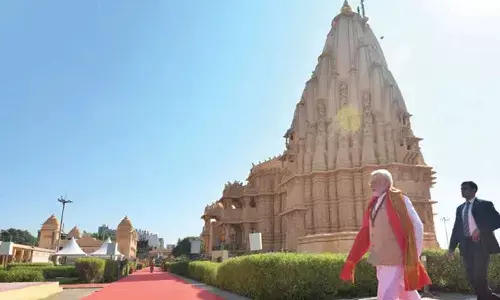Land - Its Role In Tribal Development

The alienation of tribals’ land is the result of certain historical factors. These issues continued to thrive and flourish till date to the detriment of Adivasis.
Atram Jangu, a Gond patel, tribal chieftain locally known as `patlaal’ owned large extent of fertile land in a revenue village, entirely inhabited by aboriginal tribals. It is not far from what is called today Nirmal town, now a new district headquarter carved out from erst-while Adilabad district.
It was around the turn-off this century, the then Nizam government started construction of `great road’ through western ghats of the district. This road today known as National Highway No. 7 brought wealthy and avaricious money-lenders and traders from neighbouring districts of Telangana and Maharasthra. They realized the economic potentiality of lush green forest lands. A curtain raiser for ruthless exploitation of tribals thus emerged.
Jangu, with his innate sense of honesty, trustworthiness, affection and warmth coupled with traditional hospitality welcomed the cunning and wicked non-tribal guests with open arms. This honeymoon was short lived and bitter. The colonization of the land of the Jangu and his kinship was completed in a few years by the un-invited guests in a day light robbery.
On a bright sunny morning, the ‘Girdaavaar’ (Revenue Inspector) arrived to evict Jangu and his sibblings from the lands of their ancestors. They were found guilty in occupation of the lands over which ‘shahookars’ were conferred Patta by the government.
This was around the time Mahatma Gandhi was marching towards Dandi.
Displaced from the habitat of his ancient Gods, Jangu and his gudem people trekked the hill forest in search of new home and finally settled down at a place in the midst of dense jungle, not far from then what a tiny tribal hamlet was called ‘UTNOOR,’ now an agency track headquarter with Adilabad district Tribal Development Agency (ITDA) located there.
The ageing Jangu, with his kinsmen had cut the bushes and cleared the jungle and started cultivating small parcels of land to meet their bare subsistence. Soon after that arrived the blood relation of Nizam on a horse back with a ‘sanad’ granting him absolute rights over a large extent of thousands of acres land, including lands cultivated by Jangu and his tribesmen.
Thus an IZARA village (8) was established. Jangu and his fellow tribles became the TENENTS of Izardar.
By the mercy of the then 2nd TALUQDAR, their names were registered as PROTECTED TENANTS. From the status of `land owners’, thus, the tribal cultivators were reduced to the status of `SERFS’ by the turn of independence giving way to subjugation and serfdom in 1950s.
Fate was unfair again to Jangu- ‘karma inaction’- the Izardar sold away these lands already under cultivation of tribal tenants to a land-lord from Nanded (Maharasthra) in search of green pastures.
Heartbroken Jangu died. The unceasing burden passed on to his son `Somu’. Thus, he was caught in a pathological, but invertible existential web, a la Sisyphus!
Rendered homeless and landless, Somu and his clan cleared a piece of jungle and started cultivation again along with Mahars, who had come from Chandrapur in search of livelihood. Not long before, the forest guard arrived on the scene to correct patti (tax).
For decades the story remained the same, till Somu and others were forcibly evicted from cultivating the `Reserve Forest land’. Ironically, the non-tribal cultivators continue to enjoy their rights. It was Somu and others who were told that the Reserve Forest line was drawn that way. Their fate line too.
Amidst unending gloom and doom, a ray of hope appeared on the horizon in the form of Tenancy Certificates under the Tenancy Act, peculiar to Nizam state. Tenancy pattas were granted notionally without locating the land on ground physically.
Unending legal battles were fought from the Revenue (Forest) Courts to the High Court and then the Supreme Court. The land rights remain elusive to the actual cultivators.
Condemned to his fate, Somu abandoned all hopes. At this stage of history, a smart Tahsildar gave a piece of paper, which was termed as `Laoni’ patta resulting in yet another crash programme of assignment by the government, but the Promised Land was not in sight.
Somu was a fugitive in his homeland and alienated from his own land. The Government and `mainstream’ was absolute!!
The saga of Atram Jangu and Somu, in short, was the long drawn history of tribal alienation in the district of Adilabad.
This alienation of tribal land has provided nourishment, either directly or indirectly, to the left-wing extremism, though it would be too naïve to claim this factor alone was responsible for its germination.
(The Writer is former Sub-collector/Utnoor/Adilabad dist)










